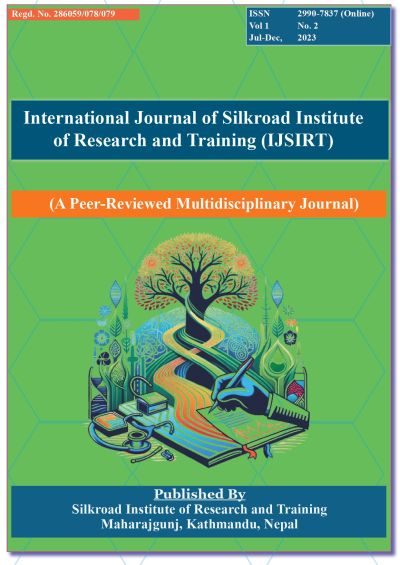Capital Adequacy and its Influence on Bank Profitability in Nepal
DOI:
https://doi.org/10.3126/ijsirt.v1i2.61771Keywords:
capital adequacy, return on assets, spread rate, return on equity, debt to equity ratio, Nepalese commercial banksAbstract
Background: Capital is a fundamental component for any organization's existence and operation. It serves as the lifeblood for initiating and sustaining businesses, regardless of their scale. The purpose of the research is to evaluate the financial performance of Nepalese commercial banks' capital adequacy ratios. Considering the performance of Nepalese commercial banks, it explicitly investigates the impact of capital adequacy ratio, cost income ratio, debt to equity ratio, equity capital to assets, bank size, and liquid ratio.
Methods: This study investigates the impact of capital adequacy on the profitability of commercial banks in Nepal, utilizing secondary data from all commercial banks spanning 2013 to 2022. Analyzing 20 commercial banks, the research reveals that Nepalese commercial banks, on average, generate a respectable profit with typical return variance. The Capital Adequacy Ratio (CAR) consistently surpasses the 10% regulatory threshold, ensuring compliance with Basel III requirements and NRB directives.
Results: The Average Assets Ratio (AAR) signifies a proactive approach to lending, contributing to enhanced profitability, while the Government Securities to Total Investment Ratio (G-STIR) indicates risk-averse practices with investments in risk-free assets. The Non-Performing Loans Ratio (NPLR) reflects the challenge of balancing low returns and high risk associated with non-performing loans. Correlation coefficients reveal complex relationships, indicating that increased capital, debt, and non-performing loans may lead to reduced profitability for Nepalese commercial banks. Regression analysis reinforces these findings, highlighting significantly negative correlations between Return on Assets (ROA), Return on Equity (ROE), and spread with capital adequacy determinants, and a positively insignificant relationship between government securities, total investment, and profitability metrics.
Conclusions: The study explored capital adequacy determinants (CAR, D-ER, AAR, G-STIR, NPLR) and their impact on bank profitability in Nepal. CAR had no significant effect on ROA, exhibiting a negative correlation. Conversely, D-ER and Advances-to-Assets Ratio positively influenced ROA. G-STIR showed a positive relationship without significance, while NPLR had a significantly negative impact. Non-risk-weighted measures, particularly debt-equity, negatively affected profitability. The study highlighted the limited impact, suggesting a more nuanced capital management approach, emphasizing D-ER and Advances-to-Assets Ratio. Consideration of macroeconomic factors and a balanced capital structure are crucial for commercial banks in Nepal.
Downloads
Downloads
Published
How to Cite
Issue
Section
License
Copyright (c) 2023 Sangita Balami, Dhan Raj Chalise

This work is licensed under a Creative Commons Attribution-ShareAlike 4.0 International License.
CC BY-SA: This license allows reusers to distribute, remix, adapt, and build upon the material in any medium or format, so long as attribution is given to the creator. The license allows for commercial use. If you remix, adapt, or build upon the material, you must license the modified material under identical terms.




